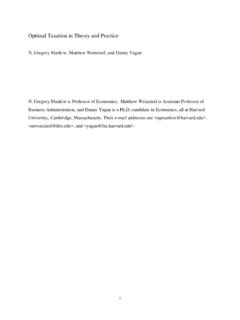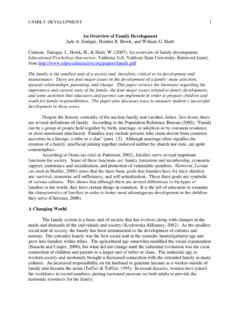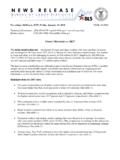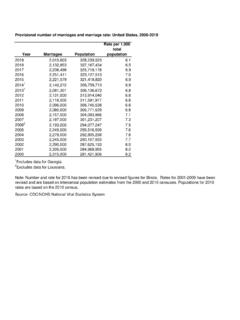Transcription of National Vital Statistics Reports
1 National VitalStatistics ReportsVolume 70, Number 2 March 23, 2021 Births: Final Data for 2019by Joyce A. Martin, , Brady E. Hamilton, , Michelle Osterman, , and Anne K. Driscoll, , Division of Vital StatisticsAbstractObjectives This report presents 2019 data on births according to a wide variety of characteristics. Trends in fertility patterns and maternal and infant characteristics are described and Descriptive tabulations of data reported on the birth certificates of the million births that occurred in 2019 are presented.
2 Data are presented for maternal age, live-birth order, race and Hispanic origin, marital status, tobacco use, prenatal care, source of payment for the delivery, method of delivery, gestational age, birthweight, and plurality. Selected data by mother's state of residence and birth rates by age are also shown. Trend data for 2010 through 2019 are presented for selected items. Trend data by race and Hispanic origin are shown for 2016 DEPARTMENT OF HEALTH AND HUMAN SERVICESC enters for Disease Control and Prevention National Center for Health Statistics National Vital Statistics SystemNCHS Reports can be downloaded from: cesareanLow-risk cesareanTotal cesarean2018201920172016 NOTES: Low-risk cesarean is cesarean delivery among nulliparous, term, singleton, and cephalic births.
3 VBAC is vaginal birth after cesarean : National Center for Health Statistics , National Vital Statistics System, of 1. Method of delivery: United States, 2016 20192 National Vital Statistics Reports , Vol. 70, No. 2, March 23, 2021 Results A total of 3,747,540 births were registered in the United States in 2019, down 1% from 2018. The general fertility rate declined from 2018 to births per 1,000 women aged 15 44 in 2019. The birth rate for females aged 15 19 fell 4% between 2018 and 2019. Birth rates declined for women aged 20 34 and increased for women aged 35 44 for 2018 2019.
4 The total fertility rate declined to 1, births per 1,000 women in 2019. Birth rates declined for both married and unmarried women from 2018 to 2019. The percentage of women who began prenatal care in the first trimester of pregnancy rose to in 2019; the percentage of all women who smoked during pregnancy declined to The cesarean delivery rate decreased to in 2019 (Figure 1). Medicaid was the source of payment for of all births in 2019. The preterm birth rate rose for the fifth straight year to in 2019.
5 The rate of low birthweight was essentially unchanged from 2018 at Twin and triplet and higher-order multiple birth rates both declined in 2019 compared with : birth certificate maternal and infant health birth rates maternal characteristics National Vital Statistics SystemIntroductionThis report presents detailed data on numbers and characteristics of births in 2019, birth and fertility rates , maternal demographic and health characteristics, medical and health care utilization, source of payment for the delivery, and infant health characteristics.
6 A report of provisional birth Statistics for 2019 presented data on selected topics based on a sample of nearly all ( ) 2019 births (1); a National Center for Health Statistics (NCHS) Data Brief presented selected characteristics based on final data for 2019 births (2). In addition to the tabulations included in this report, more detailed analysis is possible by using the annual natality public-use file. The data file may be downloaded from (3). The public-use file does not include geographic detail; a file with this information may be available upon special request (4).
7 Birth data may also be accessed via the Centers for Disease Control and Prevention s (CDC) Wide-ranging Online Data for Epidemiologic Research (WONDER). Wonder is a user-friendly Web system that makes CDC's information resources available to public health professionals and the public (5). 2003 revision of Standard Certificate of Live Birth Starting in 2016, all 50 states, the District of Columbia ( ), Puerto Rico, Guam, Commonwealth of the Northern Marianas, and Virgin Islands reported data based on the 2003 Certificate of Live Birth.
8 American Samoa continued to report based on the 1989 birth certificate revision. Internet-only tables on a number of additional topics, such as births by attendant and place and delivery, mean age of mother by live-birth order, maternal prepregnancy body mass index, infections during pregnancy, and maternal morbidity, are also available; see List of Detailed Tables. For information on data quality, see Reports that assessed the quality of selected medical and health data from the 2003 revised birth certificate and the "User Guide to the 2019 Natality Public Use File" (6 8).
9 MethodsData shown in this report are based on 100% of the birth certificates registered in all states and More than 99% of births occurring in the United States are registered (8). Tables showing data by state also provide separate information for Puerto Rico, Guam, and Commonwealth of the Northern Marianas. These areas, however, are not included in totals for the United States. Data for the Virgin Islands and American Samoa were not available for 2003 revision of the Standard Certificate of Live Birth allows the reporting of more than one race (multiple races) for each parent (9), in accordance with the revised standards issued by the Office of Management and Budget (OMB) in 1997 (10).
10 Starting in 2016, all 50 states, , Puerto Rico, Guam, Northern Marianas, and Virgin Islands reported race data in accordance with these 1997 OMB standards that allow for the reporting of a minimum of five race categories either by single race ( , reported alone) or in combination ( , more than one race or multiple races) (10). The race and Hispanic-origin groups shown in this report follow the 1997 standards and differ from the bridged-race categories shown in most previous Reports that are based on data from 2015 and earlier (11). The new categories are: non-Hispanic single-race white, non-Hispanic single-race black or African American, non-Hispanic single-race American Indian or Alaska Native (AIAN), non-Hispanic single-race Asian, non-Hispanic single-race Native Hawaiian or Other Pacific Islander (NHOPI), and Hispanic (for brevity, text references to non-Hispanic white or non-Hispanic black women omit the term single-race.)

















